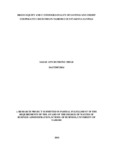| dc.description.abstract | The aspect of maintaining customer loyalty is explained to be a product of brand equity from one context to another. There exist gaps in explanations of the relationship between brand equity and customer loyalty from marketing literature thus the pertinence of this study in the Cooperative Societies in Kenya. The research project aimed to illustrate the relationship between brand equity and customer loyalty of Cooperative Societies in Kenya. The particular purpose of the research project was to establish the correlation of brand equity on customer loyalty of Savings Credit cooperative societies in Nairobi City County. This research work was anchored on brand equity theory and supported by consumer utility and SERVQUAL theories. The adopted research design was cross-sectional. The target population of the study was 4,014 customers selected from 43 Sacco’s operating in Nairobi City County. The list of respondents was obtained from customer records of the selected Sacco’s of this study. The analysis was on Sacco’s operating in Nairobi City County while observation was made on customers of the 43 Sacco are which were randomly selected. The sample size of 364 respondents were selected systematically using Israel formula. The raw data was collected from respondents through structured questionnaires with both open and closed ended questions Further to that, secondary data was deduced from published materials such as financial records, marketing plans and related sessional papers. Validity of the instrument was determined using marketing experts and scholars at the University of Nairobi while how reliable the data is was determined using Cronbach’s Alpha values more than 0.7. Data analysis was by use of Statistical Package for Social Sciences (SPSS version 24). Descriptive analysis included average scores, deviations, percentages and distribution tables which were used to summarize the responses. This standard manipulation was to elaborate the magnitude of variations. Multiple regressions were conducted at 95% to show the statistical relationship between chosen variables. Results were tabulated in tables and figures. The results of the study revealed that there exists a notable significant relationship between brand equity and customer loyalty in Cooperative Societies in Kenya. However, the study concludes that regardless of the fact that there was a relationship between brand equity and customer loyalty, it was observed that most of the Sacco’s did not embrace brand equity practices of brand loyalty, brand awareness and brand association. These findings recommend that in order for Sacco’s to enhance customer loyalty, marketing leaders should ensure that they improve services and develop new products through innovation, use alternative channels of communication to market their products and use multiple marketing techniques to position their products in the market such as brand characters, organizational attributes and modern technologies in marketing their products and services. | en_US |



